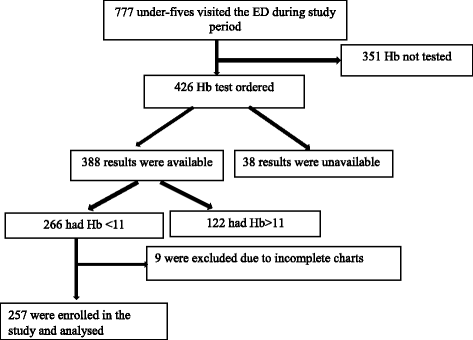Emergency blood transfusion practices among anaemic children presenting to an urban emergency department of a tertiary hospital in Tanzania
- PMID: 29152308
- PMCID: PMC5681767
- DOI: 10.1186/s12878-017-0091-y
Emergency blood transfusion practices among anaemic children presenting to an urban emergency department of a tertiary hospital in Tanzania
Abstract
Background: Severe anaemia contributes significantly to mortality, especially in children under 5 years of age. Timely blood transfusion is known to improve outcomes. We investigated the magnitude of anaemia and emergency blood transfusion practices amongst children under 5 years presenting to the Emergency Department (ED) of Muhimbili National Hospital (MNH) in Tanzania.
Methods: This prospective observational study enrolled children under 5 years old with anaemia, over a 7-week period in August and September of 2015. Anaemia was defined as haemoglobin of <11 g/dL. Demographics, anaemia severity, indications for transfusion, receipt of blood, and door to transfusion time were abstracted from the charts using a standardized data entry form. Anaemia was categorized as severe (Hb <7 g/dL), moderate (Hb 7-9.9 g/dL) or mild (Hb 10-10.9 g/dL).
Results: We screened 777 children, of whom 426 (55%) had haemoglobin testing. Test results were available for 388/426 (91%), 266 (69%) of whom had anaemia. Complete data were available for 257 anaemic children, including 42% (n = 108) with severe anaemia, 40% (n = 102) with moderate anaemia and 18% (n = 47) with mild anaemia. Forty-nine percent of children with anaemia (n = 125) had indications for blood transfusion, but only 23% (29/125) were transfused in the ED. Among the non-transfused, the provider did not identify anaemia in 42% (n = 40), blood was not ordered in 28% (n = 27), and blood was ordered, but not available in 30% (n = 29). The median time to transfusion was 7.8 (interquartile range: 1.9) hours. Mortality was higher for the children with severe anemia who were not transfused as compared with those with severe anaemia who were transfused (29% vs 10%, p = 0.03).
Conclusion: The burden of anaemia is high among children under 5 presenting to EMD-MNH. Less than a quarter of children with indications for transfusion receive it in the EMD, the median time to transfusion is nearly 8 h, and those not transfused have nearly a 3-fold higher mortality. Future quality improvement and research efforts should focus on eliminating barriers to timely blood transfusion.
Keywords: Anaemia; Emergency blood transfusion; Emergency medicine department; Paediatric; Tanzania.
Conflict of interest statement
Ethics approval and consent to participate
Ethical clearance was obtained from the Research and Publications Committee of Muhimbili University of Health and Allied Sciences (MUHAS) and Muhimbili National Hospital (MNH). Signed, informed consent was obtained from the children’s parent(s) or guardians.
Consent for publication
Not applicable.
Competing interests
The authors declare that they have no competing interests.
Publisher’s Note
Springer Nature remains neutral with regard to jurisdictional claims in published maps and institutional affiliations.
Figures


Similar articles
-
Anaemia and blood transfusion in African children presenting to hospital with severe febrile illness.BMC Med. 2015 Feb 2;13:21. doi: 10.1186/s12916-014-0246-7. BMC Med. 2015. PMID: 25640706 Free PMC article. Clinical Trial.
-
Effect of blood transfusion on survival among children in a Kenyan hospital.Lancet. 1992 Aug 29;340(8818):524-8. doi: 10.1016/0140-6736(92)91719-o. Lancet. 1992. PMID: 1354285
-
Survival and haematological recovery of children with severe malaria transfused in accordance to WHO guidelines in Kilifi, Kenya.Malar J. 2008 Dec 16;7:256. doi: 10.1186/1475-2875-7-256. Malar J. 2008. PMID: 19087286 Free PMC article.
-
Recombinant human erythropoietin in the treatment of cancer-related or chemotherapy-induced anaemia in patients with solid tumours.Med Oncol. 1998 Aug;15 Suppl 1:S19-28. Med Oncol. 1998. PMID: 9785333 Review.
-
Guidelines and recommendations for the management of anaemia in patients with lymphoid malignancies.Drugs. 2007;67(2):175-94. doi: 10.2165/00003495-200767020-00002. Drugs. 2007. PMID: 17284083 Review.
Cited by
-
Profile and outcome of patients with upper gastrointestinal bleeding presenting to urban emergency departments of tertiary hospitals in Tanzania.BMC Gastroenterol. 2019 Dec 10;19(1):212. doi: 10.1186/s12876-019-1131-9. BMC Gastroenterol. 2019. PMID: 31823741 Free PMC article.
-
Severe childhood anemia and emergency blood transfusion in Gadarif Hospital, eastern Sudan.PLoS One. 2019 Dec 3;14(12):e0225731. doi: 10.1371/journal.pone.0225731. eCollection 2019. PLoS One. 2019. PMID: 31794569 Free PMC article.
-
Multiple Concurrent Illnesses Associated with Anemia in HIV-Infected and HIV-Exposed Uninfected Children Aged 6-59 Months, Hospitalized in Mozambique.Am J Trop Med Hyg. 2020 Mar;102(3):605-612. doi: 10.4269/ajtmh.19-0424. Am J Trop Med Hyg. 2020. PMID: 31933456 Free PMC article.
-
Emergency care systems in Africa: A focus on quality.Afr J Emerg Med. 2020;10(Suppl 1):S65-S72. doi: 10.1016/j.afjem.2020.04.010. Epub 2020 Jun 17. Afr J Emerg Med. 2020. PMID: 33318905 Free PMC article.
-
Use of point-of-care haemoglobin tests to diagnose childhood anaemia in low- and middle-income countries: A systematic review.Trop Med Int Health. 2024 Feb;29(2):73-87. doi: 10.1111/tmi.13957. Epub 2023 Dec 3. Trop Med Int Health. 2024. PMID: 38044262 Free PMC article.
References
-
- Chan M. Anaemia prevention and control [Internet]. WHO. 2014 [cited 2014 Dec 26]. Available from: http://www.who.int/medical_devices/initiatives/anaemia_control/en/.
-
- Murila FV, Macharia WM, Wafula EM. Iron deficiency anaemia in children of a peri-urban health facility. East Afr Med J. 1999;76(9):520–523. - PubMed
LinkOut - more resources
Full Text Sources
Other Literature Sources

